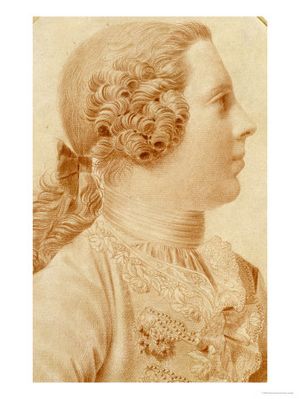Giles Hussey facts for kids
Giles Hussey (born 1710, died 1788) was a talented painter from Dorset, England. He was known for his amazing portraits. But he also had some very unique ideas about art that he really wanted people to notice. For example, he believed that every musical note had its own special color! Giles Hussey painted the very first portrait of Charles Edward Stuart, who wanted to be the King of Britain. Today, you can even see some of Hussey's paintings in the famous Tate Gallery.
Contents
Early Life and Training
Giles Hussey was born in 1710 in a village called Marnhull in Dorset. He was one of many children, the tenth of thirteen! His parents, John and Mary Hussey, sent him to France for his education. He studied at Catholic schools in Douay and St Omer.
When he came back to England, Giles began learning how to paint portraits. He became an apprentice to a well-known painter named Jonathan Richardson. Later, he worked with another artist, Francesco Riari. He even helped a Venetian artist named Vincenzo Damini paint pictures of bishops in Lincoln Cathedral.
Damini once saved Hussey from a dangerous fall while they were painting! As a thank you, Hussey's parents gave them money. This allowed Giles and Damini to travel to Italy together.
Adventures in Italy
In 1730, Giles Hussey and Damini traveled through France. They spent a lot of money on their journey. Sadly, Damini then left Giles alone in Bologna, Italy, and took his belongings.
Luckily, Giles was helped by a kind man named Signor Ghislonzoni. This man had once been an ambassador in London. He became a good friend to Giles. Hussey stayed in Bologna until 1733. Then, he finally traveled to his original goal: Rome.
Art Theories and Famous Portraits

In Rome, Giles Hussey worked with an artist named Ercole Lelli. This is where Giles started to develop his own special ideas about art. He wanted to use math to figure out what made art beautiful. He carefully measured many old statues. He believed he found a "Harmonic Scale" that was key to their beauty.
Hussey also thought that musical notes could be matched with colors. For example, he believed the note "A" was red, and "A flat" was violet.
One of Hussey's most famous paintings is a portrait of Charles Edward Stuart. Charles was known as the "Young Pretender." He was trying to become the King of Britain. These portraits were very accurate. But some people thought they showed Hussey's strong focus on his art theories.
Giles Hussey was the first British artist to paint Charles Edward Stuart. He first painted him in 1734. He made several different versions of this portrait. A second painting was done in 1737. It showed Charles as a knight in black armor. An oil painting of this sketch was made, but no one knows where it is now.
Return to England and Later Life
In 1737, Hussey returned to England. He was excited to share his new art theories. But sadly, not many people paid attention to them.
To earn money, he went back to painting portraits. He painted important people like Matthew Duane, who collected old coins, and the Duke of Northumberland. In 1742, the Duke even offered Hussey a room in his house and a servant. But Hussey said no because he also wanted a Catholic priest, which the Duke wouldn't provide.
Hussey made more drawings of "Bonnie Prince Charlie" (Charles Edward Stuart) in 1742. He probably based these on a sculpture of the prince. For the next twenty years, Giles Hussey was disappointed. His art theories still didn't get much attention.
In 1768, he stopped painting completely. He inherited his family's home in Marnhull after his older brother died. So, he started gardening instead.
In 1787, Hussey's nephew, John Rowe, changed his last name to Hussey. John lived in Beaston House in Broad Hempston, Devon. Giles Hussey had been living with him for several years. John inherited Giles's money and property.
Giles Hussey passed away in June 1788. He was buried in Broad Hempston, Devon. Even though he lived away from the art world at the end, his paintings and drawings became very valuable. People really appreciated his amazing detail. His drawings of the "Old Pretender" and "Young Pretender" sold for high prices.


